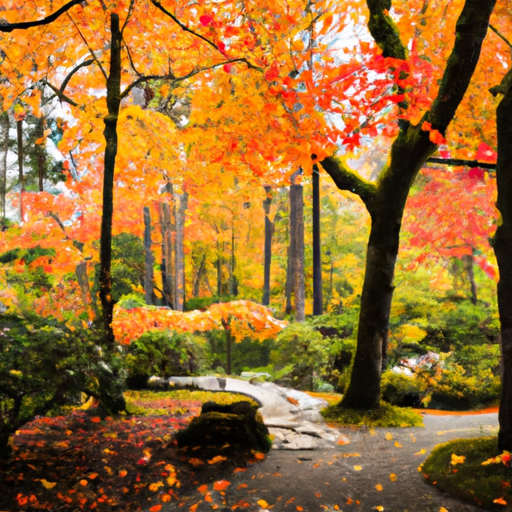Imagine embracing each change that nature presents throughout the year, transforming it from a simple occurrence into a breathtaking spectacle right in your own backyard. “Seasonal Transitions: Harnessing the Power of Changing Seasons in Japanese gardens” will lovingly guide you through the process of creating a space that mirrors the beauty and tranquility of a Japanese garden, a space that works in harmony with every season. This article not only inspires creativity; it arms you with the knowledge to understand and appreciate the art and philosophy behind the ever-evolving living masterpiece that is a Japanese garden. That’s the energy you’re about to hold in your hands: a world where your own outdoor sanctuary beautifully adapts to spring blooms, summer’s warmth, autumn leaves, and winter frost.
Understanding Seasonality in Japanese Gardens
Japanese gardens are renowned for their beauty, serenity and the profound sense of harmony they evoke. At the heart of this elegance and tranquility lies the fundamental principle of seasonality. As you immerse yourself in the enchantment of these gardens, this article will guide you through the crucial role of seasons, as well as the incorporation of seasonal elements into the successful design of a Japanese garden.
Importance of seasonal changes
In Japanese gardens, seasonal transformations are not just considered, but celebrated. From the first blush of spring blossoms to the magical snowscapes of winter, each season introduces a distinct mood, color palette and set of sensory experiences. This highlights the fleeting nature of life, a key element in Japanese aesthetic. By understanding seasonal changes, you are able to appreciate and seek out the unique beauty provided by each season.
Connection with nature
Japanese gardens are more than just visually pleasing spaces; they’re designed to evoke strong emotional responses and provide profound connections with nature. Each garden captures the essence of the natural landscape, reflecting its beauty and fragility. The incorporation of seasonal elements not only serves to strengthen this bond with nature but also ensures that the garden remains dynamic and changing, engaging your senses in different ways as the year progresses.
Seasonality as a design feature
Within Japanese garden designs, seasonality is not an afterthought, but a fundamental design feature. A well-designed garden is planned to ensure that it offers a different beauty during each season. Elements such as plant selection, placement of structures, and elements of water and stone, all play a significant role in maintaining interest year-round.
Spring in Japanese Gardens
Spring is a time of rebirth and renewal and, in Japanese gardens, this season is marked by the magical explosion of color and fragrance.
Symbolism of spring
In Japanese gardens, spring signifies awakening and new beginnings. You’ll notice the delicate hue of fresh green leaves, the bold colors of flowers in bloom, and the lively sounds of birds singing after the quiet winter months. This amplifies the feelings of hope and rejuvenity which are emblematic of this season.
The beauty of Cherry Blossoms
No discussion of spring in Japan would be complete without mention of cherry blossoms or ‘sakura.’ These ethereal beauties have a long cultural significance in Japan, symbolizing life’s fleeting moments. Their blossoms create a spectacle, covering the landscape in dreamy shades of pink and white.
Plants and trees for spring
In addition to cherry blossoms, there are several other plant species which come alive in the spring. These include plum and peach trees, azaleas, iris, and camellias, each contributing their unique beauty and fragrance.
Garden maintenance in spring
Spring garden maintenance involves pruning winter damage and adding organic fertilizers to wake plants from their winter slumber. It’s also a time for planting new annuals and bulbs, ensuring continual bloom throughout the season.
Summer in Japanese Gardens
The height of the green season, summer in Japanese gardens is lush, vibrant and teeming with life.
Symbolism of summer
Summer is seen as a period of vibrancy and maturity. The rich, dark greens of summer foliage represent strength, vitality, and the fullness of life.
The brilliance of Hydrangeas
Few plants capture the essence of summer in Japan as well as hydrangeas. Their big, round heads full of blooming flowers provide the lushness and color that symbolize this season.
Lush summer greens
Between the numerous shades of green, from the bright, fresh hues to the darker, mature tones, summer allows Japanese gardens to showcase their lush vegetation. Maple trees, bamboo, moss, and hostas, all these contribute to the green symphony.
Garden maintenance in summer
Summer garden maintenance involves mostly watering, weeding and protecting your plants from pests. This is also an ideal season for you to sit back, relax and enjoy the result of your spring efforts.
Autumn in Japanese Gardens
Autumn brings a breathtaking palette of fiery hues, cooler temperatures, and a deeper sense of tranquility.
Symbolism of autumn
Autumn represents maturity and fulfillment. It is a period of appreciation, reflection and gratitude for the bounty of life.
The lovely momiji (Japanese maples)
The Momiji, or Japanese maples, are the stars of autumn. These trees showcase a stunning array of colors, from bright yellows to deep reds, creating a visual feast that perfectly captures the essence of the season.
Plants and trees turning to fall colors
In addition to the momiji, several tree species like ginkgo and katsura, contribute to the vibrant fall landscape of the Japanese garden. The changes seen in autumn foliage occur as temperatures drop and daylight hours lessen, reminding us of the cyclicality of life.
Garden maintenance in autumn
During autumn, garden maintenance consists of raking leaves and composting them, providing organic material for improving soil fertility. It’s also the best time to plant any new trees or perennials, taking advantage of the cooler temperatures and more frequent rainfall.
Winter in Japanese Gardens
Winter turns the Japanese garden into a tranquil and elegant landscape, focusing on the sculptural beauty of trees and rocks.
Symbolism of winter
Winter represents dormancy, reflection, and the underlying potential within all living things. Despite its inherent quietness, it serves as a reminder that rest is essential for rebirth.
The tranquility of snowy landscapes
Snowy landscapes provide a mesmerizing monochrome beauty, significantly transforming the garden. The snow-covered trees, stones, and even garden structures all acquire a new calm and serene beauty.
Winter-flowering plants
Although winter in Japanese gardens is mostly about appreciating the bare forms of deciduous trees and shrubs, there are plants that flower during this season. These include camellias and witch hazel, beautifully contrasting the stark winter landscape with their vibrant blooms.
Garden maintenance in winter
Winter is generally a quieter season in the garden. However, it’s a good time to keep an eye on weather conditions and protect your plants from harsh climate impacts, such as snow load or intense winds. Pruning and preparing the garden for spring also becomes part of the winter tasks.
Incorporating Elements of Seasonal Transitions
Between each season is a transition period that transforms the landscape, creating a fluid and ever-evolving garden. Tools to achieve this are the garden’s physical elements.
Water elements
Water adds a dynamic and reflective component to Japanese gardens. Water features, like ponds and streams, embody the fluidity of nature, changing their appearance and sound based on the season.
Stone elements
Stones, in their various sizes and shapes, provide contrast and structure to the garden. They hold visual interest throughout the year, specially in winter when they become significant, giving the garden a sculptural quality.
Plants and trees for seasonal transitions
Carefully selected plants ensure constant visual interest throughout the year. Spring-flowering plants are followed by lush summer foliage, autumn’s fiery colors, and finally, the unique silhouettes seen in winter.
Incorporating wildlife
You can also enhance seasonal transition by inviting wildlife into your garden. Birds, insects, and small mammals add life and motion, changing with the seasons.
Seasonal Events and Festivities
In Japanese culture, numerous events and festivals are centered around the changing of seasons, reinforcing the deep bond with nature.
Hanami: Cherry blossom viewing
Hanami, or cherry blossom viewing, is a joyous event during spring, where friends, family, or even coworkers gather under flowering sakura trees for picnics and parties.
Tsuyu: Rainy season activities
Tsuyu, the rainy season, usually lasting from mid-June to mid-July, has its own share of activities. It’s the perfect time to nurture hydrangeas or ‘ajisai’ and other rain-loving plants.
Koyo: Autumn leaves viewing
Koyo or autumn leaf viewing, similar to Hanami, is a time to gather and appreciate the color-changing leaves, especially the spectacular momiji.
Setsubun: End of Winter celebration
Setsubun is a festival marking the end of winter. It is well-known for its bean-throwing ritual, which is believed to drive away evil spirits and bring good luck.
Organic Practices for Seasonal Transitions
Creating a healthy, resilient garden means working with nature rather than against it. Following organic garden practices ensures that your garden thrives through the seasonal transitions.
Natural pruning techniques
Pruning techniques like ‘niwaki’ work in favor of the plant’s natural growth habits rather than against them, keeping them healthy and looking their best throughout the seasons.
Organic fertilizers
Feeding your garden with homemade composts and organic fertilizers ensures the soil stays fertile year-round and reduces harmful chemical use in your garden.
Water conservation
As water is crucial to all living things, conserving it through strategies like collecting rainwater, using mulch, or planting drought-resistant species is highly significant and environment-friendly.
Encouraging beneficial insects and animals
Small creatures such as insects, birds or even microorganisms contribute to the overall health of your garden. By creating a welcoming habitat for them, you ensure a balanced ecosystem within your garden.
Garden Structures and Seasonality
Garden structures play a significant role in maintaining aesthetic interest throughout the year and are fundamental design elements in Japanese gardens.
Design of tea houses
Tea houses, deeply rooted in Japanese culture, offer a serene vantage point to enjoy the changing views through the seasons.
Placement and design of bridges
From a structural perspective, as well as a spiritual symbol, bridges are important features of Japanese gardens. The design and placement of a bridge significantly influence one’s experience through seasonal changes.
Pathways and stepping stones
Pathways and stepping stones guide the visitor, dictating the pace, direction, and views to be savored. They effectively invite one to experience the garden from different perspectives in different seasons.
Lanterns and other decorative elements
Lanterns, basins and other decorative elements enhance the ambience and contribute to the overall aesthetics, creating visual interest in the garden through all seasons.
Breathing Life into Gardens through Seasonal Transitions
In summation, effectively harnessing the power of changing seasons can bring fluidity and life to your garden.
Living in harmony with the season
Seek harmony with each season, capturing the essence and the unique beauty it offers. Experience these fleeting moments, learn from them, and feel the powerful connection with nature.
Essential elements of a four-seasons garden
A four-seasons garden requires careful planning and thought. It involves selecting the right mix of elements – from plants and trees to garden structures and water features, that will thrive and provide interest in all seasons.
Experiencing the garden at different times of the day and year
Finally, always remember to take time to immerse yourself in the garden at different times of the day and year. Whether it’s a cool summer morning, a vibrant autumn afternoon, or a quiet winter evening, each has its unique essence.
Through each magnificent season, your garden can offer different emotions, sceneries, and experiences. Embrace the beauty of seasonality in Japanese gardens, and it will bring you joy and serenity all year round.








